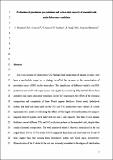Por favor, use este identificador para citar o enlazar a este item:
http://hdl.handle.net/10261/16030COMPARTIR / EXPORTAR:
 SHARE SHARE
 CORE
BASE CORE
BASE
|
|
| Visualizar otros formatos: MARC | Dublin Core | RDF | ORE | MODS | METS | DIDL | DATACITE | |

| Campo DC | Valor | Lengua/Idioma |
|---|---|---|
| dc.contributor.author | Mondini, Claudio | es_ES |
| dc.contributor.author | Cayuela, María Luz | es_ES |
| dc.contributor.author | Sinicco, T. | es_ES |
| dc.contributor.author | Cordaro, F. | es_ES |
| dc.contributor.author | Roig, Asunción | es_ES |
| dc.contributor.author | Sánchez-Monedero, Miguel Ángel | es_ES |
| dc.date.accessioned | 2009-08-18T07:27:04Z | - |
| dc.date.available | 2009-08-18T07:27:04Z | - |
| dc.date.issued | 2007-06 | - |
| dc.identifier.citation | Soil Biology and Biochemistry 39(6): 1366-1374 (2007) | es_ES |
| dc.identifier.issn | 0038-0717 | - |
| dc.identifier.uri | http://hdl.handle.net/10261/16030 | - |
| dc.description | 9 pages, 4 figures, 2 tables. | es_ES |
| dc.description.abstract | Soil sequestration of atmospheric CO2 through land application of organic residues may have beneficial effects as a strategy to offset the increase in the concentration of greenhouse gases (GHG) in the atmosphere. The significance of different variables on GHG production and soil C sink capacity was investigated by monitoring CO2 and N2O fluxes from amended soils under laboratory conditions. In the first experiment, the effects of the chemical composition and complexity of three N-rich organic fertilisers (blood meal, hydrolysed leather, and hoof and horn meal) on the CO2 and N2O productions were studied. A second experiment was aimed at evaluating the effects of the degree of transformation of composts prepared from two-phase olive mill waste on soil C sink capacity. The three N-rich organic fertilisers caused different CO2 and N2O evolution patterns in the amended soils, despite their similar elemental composition. The total amount of added C that was mineralised in the soil ranged from 10.4% to 15.5%, while N2O–N originating from horn and hoof meal was 6 and 13 times higher than that coming from hydrolysed leather and blood meal, respectively. Mineralisation of the C added to the soil was inversely correlated to the degree of stabilisation of the composting mixtures. Soils amended with the initial composting mixture evolved from 2 to 7.3 times more CO2–C than the soil amended with the more stabilised compost. However, the C conservation efficiency of organic residues, calculated by the combined losses during composting, and after land application, was higher for the less transformed organic materials. Both studies showed the key importance of the variables studied on the GHG emissions and C sink efficiency of amended soils under controlled conditions. Laboratory experiments could be a useful tool to assist in the designing of field scale experiments for an effective quantification and monitoring of the overall changes in soil C and N pools. | es_ES |
| dc.description.sponsorship | This research was supported by a grant from the Italian Ministry for Agricultural and Forestry Policies (MiPAF), Project PARSIFAL, General Series, Paper No. 18. The authors wish to thank the Spanish Comisión Interministerial de Ciencia y Tecnologia (CICYT) for supporting the research project under which this work was partially financed. | es_ES |
| dc.format.extent | 259768 bytes | - |
| dc.format.mimetype | application/pdf | - |
| dc.language.iso | eng | es_ES |
| dc.publisher | Elsevier | es_ES |
| dc.relation.isversionof | Postprint | es_ES |
| dc.rights | openAccess | es_ES |
| dc.subject | C sink capacity | es_ES |
| dc.subject | GHG emissions | es_ES |
| dc.subject | Organic residues | es_ES |
| dc.subject | Composting | es_ES |
| dc.subject | Degree of stabilisation | es_ES |
| dc.subject | Chemical complexity | es_ES |
| dc.title | Greenhouse gas emissions and carbon sink capacity of amended soils evaluated under laboratory conditions | es_ES |
| dc.type | artículo | es_ES |
| dc.identifier.doi | 10.1016/j.soilbio.2006.12.013 | - |
| dc.description.peerreviewed | Peer reviewed | es_ES |
| dc.relation.publisherversion | http://dx.doi.org/10.1016/j.soilbio.2006.12.013 | es_ES |
| dc.rights.license | https://creativecommons.org/licenses/by-nc-nd/4.0/ | es_ES |
| dc.contributor.funder | Ministero delle Politiche Agricole Alimentari e Forestali | es_ES |
| dc.relation.csic | Sí | es_ES |
| dc.identifier.funder | http://dx.doi.org/10.13039/501100005401 | es_ES |
| dc.type.coar | http://purl.org/coar/resource_type/c_6501 | es_ES |
| item.openairetype | artículo | - |
| item.grantfulltext | open | - |
| item.cerifentitytype | Publications | - |
| item.openairecristype | http://purl.org/coar/resource_type/c_18cf | - |
| item.fulltext | With Fulltext | - |
| item.languageiso639-1 | en | - |
| Aparece en las colecciones: | (CEBAS) Artículos | |
Ficheros en este ítem:
| Fichero | Descripción | Tamaño | Formato | |
|---|---|---|---|---|
| Mondini2007SoilBiolBiochem.pdf | Articulo principal | 191,26 kB | Adobe PDF |  Visualizar/Abrir |
CORE Recommender
SCOPUSTM
Citations
28
checked on 27-mar-2024
WEB OF SCIENCETM
Citations
28
checked on 22-feb-2024
Page view(s)
416
checked on 19-abr-2024
Download(s)
5
checked on 19-abr-2024
Google ScholarTM
Check
Altmetric
Altmetric
Este item está licenciado bajo una Licencia Creative Commons

